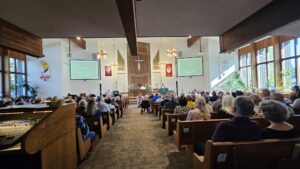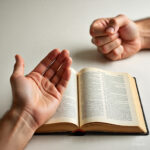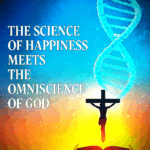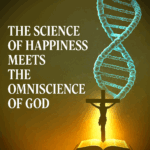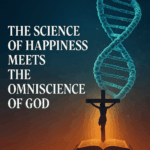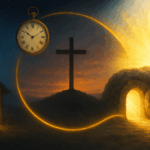“My Hope is Built on Nothing Less: Hymns/Songs that Secure Us” – Hymn 576/Cornerstone
1. The story behind the hymn
Edward Mote was another hymn writer who grew up without religious training. His parents were pub owners. He was apprenticed at a young age by his parents to a cabinetmaker, but found faith at a Chapel in London at age 15. Living near London, he established a successful cabinet-making enterprise and became a Baptist minister in 1852, at 55 years of age. But it was some 20 years earlier that he authored the hymn, “My Hope is Built on Nothing Less.” He was interested in hymns and wrote more than 100 hymns in his career. Mote, himself, tells the story of the origin of this hymn as it appeared in a London periodical, The Gospel Magazine:“One morning it came into my mind as I went to labour, to write a hymn on the ‘Gracious Experience of a Christian.’ As I went up to Holborn I had the chorus… [Later] In the day I had four verses complete, and wrote them off…. On the Sabbath following… by the fireside [I] composed the last two verses.”Baptist hymnologist William Reynolds summarizes the rest of the story: “The next Sunday [Mote] visited the home of some fellow church members where the wife was very ill. The husband informed Mote that it was their custom on the Lord’s Day to sing a hymn, read the Bible, and pray together. Mote produced the new hymn from his pocket, and they sang [“The Solid Rock”] together for the first time.”
The hymn has found its way into our Lutheran hymnbooks for at least the last 80 years, with our most recent hymnal featuring it with two different melodies. Ten years ago, Hillsong Music released a worship song – “Cornerstone” – that includes the verses of “My Hope is Built” but uses a different refrain. (That’s what we’re going to sing today.) The popularity of the hymn’s imagery is further seen in a more recent release of “My Feet Are on the Rock” by a group called “I Am They.” It uses the hymnal version of the refrain. So, let’s explore the lyrics of Mote’s hymn.
2. Jesus’ name, blood and righteousness (v.1)
My hope is built on nothing less Than Jesus’ blood and righteousness;
No merit of my own I claim But wholly lean on Jesus’ name.
Refrain: On Christ, the solid rock, I stand; All other ground is sinking sand.
Edward Mote starts his hymn with a look toward the future, because that’s what hope is… a look toward the future. In the middle of Romans 8, we find perhaps the most thorough description of hope in the entire Bible. St. Paul writes that “we groan inwardly as we wait eagerly for our adoption… the redemption of our bodies. For in this hope we were saved. But hope that is seen is no hope at all. Who hopes for what he already has? But if we hope for what we do not yet have, we wait for it patiently.”
Paul talks about hope as something that we do not yet have, and as something for which we wait eagerly and patiently. Now some of you may know that today is Super Bowl Sunday – the football championship in the U.S. I don’t care about it that much, but I do know that the Cincinnati Bengals are in their first Super Bowl in more than 30 years, and they have never won the championship in their 50-year history. So, if you’re a Bengals fan, you are hoping for a victory this afternoon. You don’t know if it’s going to happen, because the game hasn’t been played yet, but you’re hoping.
Paul is talking about the future event of the redemption of our bodies. Right now, here on earth, we live in these bodies that are subject to brokenness – injury, disease, decay, and sin. But our future hope is for redeemed bodies, glorified bodies, spiritual bodies, perfect bodies. That will happen at the resurrection, and it’s in heaven that we will have those redeemed bodies.
Edward Mote is looking to that future hope – going from earth to heaven. (**volunteer – visual image) And he writes that his hope is based “on nothing less.” Now there are people in this world whose hopes are built on much lesser and much less certain things. I referred to this hymn as a hymn that secures us. Some people build their hopes and their lives on the security of money and possessions, with that motto of “He who dies with the most toys wins.” Others rely on their own selves and skills and egos, with that deceptive slogan of “You can fulfill your dreams, you can do whatever you set your mind to, you can be whatever you want to be.” Still others try with all their might and intentions to please God with their lives and good deeds. Some people build their hopes for life after death on shaky teachings and religions that have no basis in truth.
In contrast, while those philosophies are wallowing around ankle level in terms of their truthfulness and security, Mote says that his hope, his security is built on nothing less than Jesus’ blood and righteousness. He is not satisfied with any of those lesser and uncertain teachings. He wants nothing but the best, the strongest, the most truthful, the most secure. So, he relies on NOTHING LESS than Jesus, and Jesus’ blood shed on the cross of Calvary, and the righteousness that comes to us freely from that sacrifice.
In Romans 3, Paul spends a few verses expanding on that righteousness theme. He says that we can’t attain a right and righteous relationship with God by observing the law, by trying to be perfect. But God, Himself, has provided another source of righteousness – one that comes from Him, through faith in Jesus, through faith in His blood. Paul summed up the result of Jesus’ crucifixion by saying that “God made [Jesus] who had no sin to be sin for us, so that in Him we might become the righteousness of God.”
This morning, two precious infants were presented for Baptism, clothed in robes of white. Those robes represent the holiness, the purity, the righteousness that Jesus clothes us with by virtue of our faith in His death and resurrection. That’s what Mote says, his hope is nothing less than that. The next phrase re-states it – “No merit of my own I claim But wholly lean on Jesus’ name.” That is to say, no matter how good and holy Mote’s life was, no matter how many good deeds I have done, no matter how generous your offerings have been or how much service you have given to the church… NONE of that counts toward our righteousness. Once we claim our own merit, we negate and reduce Jesus’ own sacrifice and righteousness for us. So, Mote acknowledges that He will lean wholly, entirely, fully on Jesus’ name, Jesus’ blood and Jesus’ righteousness. It’s exactly what St. Peter said in Acts 4 when he was called to give an account for the healing of a lame man before the religious authorities. He boldly proclaimed, “Salvation is found in no one else, for there is no other name under heaven… by which we must be saved.” NOTHING LESS than Jesus!! ONLY Jesus!!
So now we get to the refrain… On Christ, the solid rock, I stand; All other ground is sinking sand.
This is a pretty obvious connection with a story that Jesus told about two builders. One man built his house on a rock, the other man on sand. When the wind and rains came to blow and beat against those houses, the house on the rock stood firm, while the house built on the sand fell with a great crash. Jesus was really saying that if you build your life on those insecure slogans and shaky teachings, you need to know that that is really a sinking sand foundation, and one day it will all come crashing down around you! Mote concludes by saying that He is going to stand solidly and securely on Christ. When St. Peter confessed Jesus to be the Christ, Jesus’ reply indicated that Peter’s confession was a solid, rock-like statement on which a person could build their life, their faith, and their eternity. Oh, and the refrain from the version we are going to sing today includes a reference to Christ as cornerstone, which is another image of strength in the building of a house. St. Paul, writing to the Christians in Ephesus, uses that imagery to describe us in the church – we are God’s people built on the foundation of the apostles and prophets (that would be the New Testament Scriptures and the Old Testament Scriptures), with Christ Jesus, Himself, as the chief cornerstone. On Christ the solid rock, on Christ the cornerstone – same picture.
3. My anchor: Christ’s unchanging grace (v.2)
When darkness veils his lovely face, I rest on his unchanging grace;
In ev’ry high and stormy gale My anchor holds within the veil.
Refrain: On Christ, the solid rock, I stand; All other ground is sinking sand.
The second verse of Mote’s hymn takes us back to that nautical theme that we hard from Horatio Spafford last Sunday. But before that, Mote refers to a different image – “When darkness veils His lovely face.” That darkness could be literal darkness, but more likely figurative darkness. When the earth turns and darkness envelopes our area, the lovely, warming, bright face of the sun is veiled and hidden. In that darkness we have a hard time finding our way. Many crimes and misdeeds are often done under the cover of darkness, so as not to be noticed, and recognized and identified. That leads us to figurative darkness. That darkness of crime and suffering and injustice and evil seems to veil God’s face for many people, and it leads them to believe that God is either a myth or He’s uncaring or He’s dead. Maybe you have some of those doubts about God when things are not going well for you in life, when darkness seems to obstruct God’s light from getting through.
Mote says that even then, maybe especially then, he rests on the unchanging character of God, the unchanging grace of God. James chapter 1 tells us that God does not change like shifting shadows. We still have pretty long shadows these days, because the sun is still quite low in the sky, but those shadows are changing. And they change during the day, too, with long shadows in the morning and evening, and shorter shadows at mid-day. Whether it’s the darkness of night, or the brightness of noon-day, whether it’s the darkness of trials and temptations, or the brightness of God’s abundant blessing, God does not change. His grace is constant.
Pay attention, now, to that nautical illustration. Mote talks about a high and stormy gale, and he must have the ocean in mind – like Horatio Spafford’s rolling sea billows – for he refers to the security and certainty of an anchor that holds his life in place. “My anchor holds within the veil.” Whether he meant the veil of fog or zero visibility because of that stormy gale, his life’s anchor – Jesus, and God’s grace in Jesus – is going to keep him firm. That’s the image that the writer to the Hebrews uses: “hope is an anchor for the soul, firm and secure.”
Does God’s face, does God’s grace, seem to be veiled and dark for you right now? Is there a high and stormy gale whipping up on the horizon, threatening to overwhelm your little boat of life with waves too big and boisterous to endure? Know that Jesus is your anchor, and that He holds you!
4. My hope… His oath, covenant and blood (v.3)
His oath, his covenant, his blood Sustain me in the raging flood;
When all supports are washed away, He then is all my hope and stay.
Refrain: On Christ, the solid rock, I stand; All other ground is sinking sand.
The third verse returns us either to the high and stormy gale of verse 2 or to the rains and winds and raging flood of Jesus’ story of the two house builders. When that raging flood is relentless, when earthly supports and foundations are no match for the waters – kind of like the Abbotsford dikes during the fall atmospheric rivers – there is still something that supports us and gives us hope. Edward Mote identified three things that support us: God’s oath, His covenant, His blood.
His oath… I’m not exactly sure what Mote was referring to, but perhaps it was that promise to Old Testament Moses and the people of Israel that He would never leave them or forsake them, a promise that was restated for us New Testament people in the book of Hebrews. And that oath was also spoken by Jesus when He gave the Great Commission: “Go, and make disciples… baptizing and teaching… AND I will be with you always, to the end of the age.”
His covenant… again, there are several covenants mentioned in the Old Testament – the covenant with Noah not to send another flood; the covenant with Abraham that all the people of the world would be blessed by one of his descendants; the covenant with David that the Saviour would come from his family and His kingdom would endure forever. But perhaps the covenant we ought to think about is the new covenant that the prophet Jeremiah spoke of – the covenant to be our God, and to forgive our wickedness and remember our sins no more. That supports and encourages us for sure!!
His blood… that one we don’t have to wonder about – it’s definitely the blood of Jesus, spilled on the cross, precisely for the forgiveness of our sins, and to ensure us that He is our foundation, our solid rock, our hope and stay. He is why, when every earthly prop gives way – our health, our friends, our financial security – even then Jesus is our hope, our eternal hope.
5. At trumpet sound… Redeemed!! (v.4)
When he shall come with trumpet sound, Oh, may I then in him be found,
Clothed in his righteousness alone, Redeemed to stand before the throne!
Refrain: On Christ, the solid rock, I stand; All other ground is sinking sand.
Oh, and then speaking about eternal hope, Edward Mote concluded his hymn in the same way as John Newton and Horatio Spafford – with a look toward the last day. “When He shall come with trumpet sound.” That’s the same imagery – from 1 Corinthians and 1 Thessalonians and Revelation – that Spafford used to refer to the last day. Jesus will return with the trumpet call of God. Mote’s final verse prayer is that when that day comes he will be found in Christ, with faith in Christ, and he will be clothed in that righteousness of Jesus, and he will be able to stand redeemed, boldly, confidently before the very throne of God.
That’s our prayer, too, isn’t it – that we would stand confidently before God’s throne when the last day comes because we are clothed with Christ’s righteousness, and that is our – not ankle-high hope, but right-up-to-the-heart hope, our stormy-gale-anchor hope, our darkness-busting-grace hope, our oath-covenant-and-blood hope, our solid-rock hope… NOTHING LESS than Jesus’ blood and righteousness – FOR YOU!!! Let’s stand and sing this hymn of security and strength.

